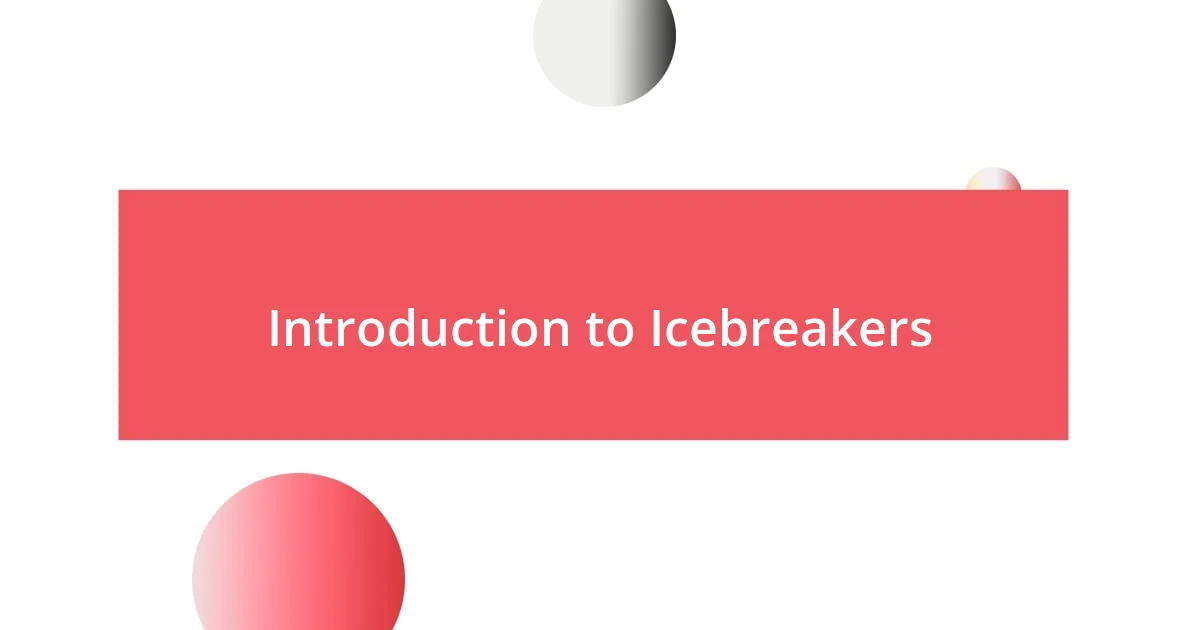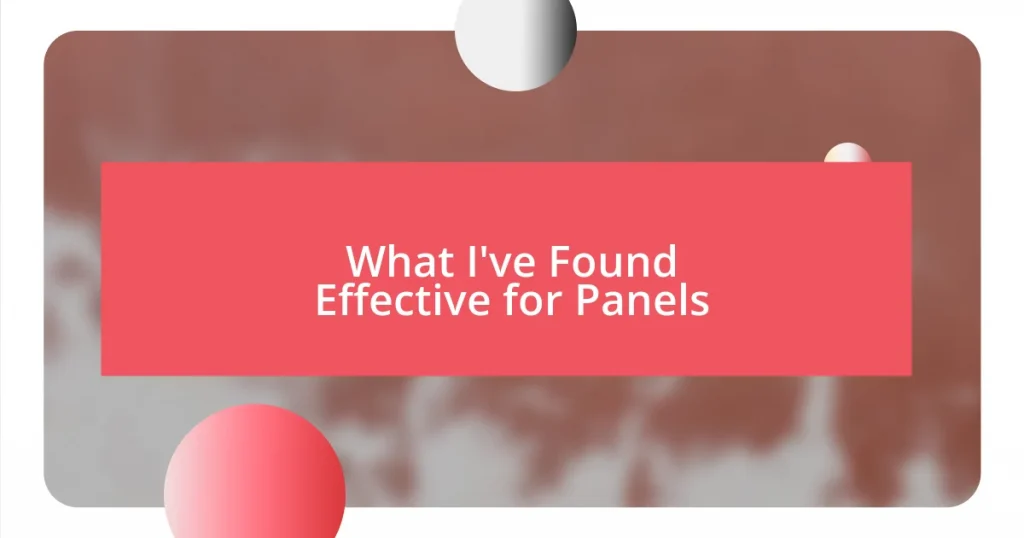Key takeaways:
- Icebreakers set the tone for panel discussions, fostering engagement, comfort, and deeper interactions among participants.
- Creative activities like “Two Truths and a Lie” and “Human Bingo” enhance connections by encouraging personal sharing and revealing common interests.
- Effective facilitation, including clear instructions and a welcoming atmosphere, significantly boosts the impact of icebreakers on group dynamics.

Introduction to Icebreakers
Icebreakers serve as the essential first step in creating a relaxed and engaging environment, especially during panel discussions. I distinctly remember the first time I attended a panel where the speaker kicked things off with a light-hearted question. The atmosphere shifted instantly; laughter replaced tension as participants shared their quirky answers, setting the stage for open dialogue. Have you ever noticed how a simple question can shatter barriers and foster connection?
When effectively chosen, icebreakers can evoke emotions and spark interest, paving the way for meaningful conversations. I once introduced a game where participants had to share an unusual talent. Watching a quiet individual surprise everyone with an impressive juggling act reminded me of the hidden potential we all have. Isn’t it fascinating how these moments can reveal unexpected sides of people?
Ultimately, the right icebreaker not only encourages participation but also cultivates a sense of community among panelists and the audience. From my experience, even the most serious topics can be approached with a touch of humor and warmth. How do you believe the energy of the room can shift with just a few well-chosen words?

Importance of Icebreakers in Panels
Icebreakers play a pivotal role in setting the tone for panel discussions. They break down initial barriers and encourage participation by inviting everyone into the conversation. I recall a panel where we kicked things off with a simple question about our favorite childhood memory. This not only warmed us up but also opened the door for deeper connections, as each panelist shared a piece of their past that resonated with the audience. It’s intriguing how a seemingly simple question can create such a rich tapestry of shared experiences.
Here are a few key reasons why icebreakers are essential in panels:
- Foster Engagement: They encourage attendees to participate and feel valued from the beginning.
- Create Comfort: A friendly opener reduces anxiety, making it easier for both panelists and the audience to connect.
- Stimulate Interaction: Icebreakers spark conversations, leading to deeper discussions throughout the panel.
- Encourage Authenticity: By sharing personal stories, panelists appear more relatable, establishing trust with the audience.
- Set the Energy: A lighthearted start can uplift the room, allowing for a more dynamic and enjoyable session.
Reflecting on my experiences, I’ve found that the energy of the room often shifts dramatically when icebreakers are included. It’s like watching a plant bloom after a drop of water—suddenly, everyone feels more alive and ready to engage in meaningful dialogue. Don’t you think it’s incredible how something so simple can transform the atmosphere?

Creative Icebreakers for Engaging Panels
Engaging panels can flourish with creative icebreakers that resonate with both panelists and the audience. I remember a panel where one of the icebreakers involved a quick round of “two truths and a lie.” It was astonishing to see how quickly everyone warmed up to each other as surprising secrets were revealed, leading to laughter and deepening connections. Have you ever played this game? It’s amazing how it can create a light but engaging atmosphere right from the start.
Another intriguing idea I’ve used is a “Question Ball” game, where a soft ball is passed around, and whoever catches it answers a fun question written on it. I once witnessed a participant who was initially shy become animated when they received a question about their favorite movie from childhood. Moments like these, where someone steps outside their comfort zone, are thrilling to observe and encourage others to do the same. Can you imagine the energy shift when people share stories that invite vulnerability?
Lastly, something I’ve found particularly effective is starting with an unusual visual prompt, like showing a quirky photo. At one panel, I displayed a picture of a mixed-up breakfast plate, and each person interpreted it in their way. The interpretations were hilariously different, and this not only broke the ice but also highlighted how diverse perspectives can be within a group. Isn’t it refreshing to see how a single image can spark such varied thoughts and laughter among strangers?
| Icebreaker Type | Description |
|---|---|
| Two Truths and a Lie | A fun game that encourages sharing surprising personal facts, fostering connection. |
| Question Ball | A soft ball is thrown, and the catcher answers a light-hearted question, enhancing engagement. |
| Visual Prompt | A quirky image is shown, prompting diverse interpretations that spark laughter and discussion. |

Activities to Build Team Rapport
One activity that truly resonates with my experience in building team rapport is the “Human Bingo” game. Each participant receives a bingo card filled with various traits or experiences, such as “has traveled to three countries” or “has a pet.” I remember a panel where one participant excitedly shouted, “Bingo!” after finding that she shared a unique travel story with another participant. This not only sparked conversations but also uncovered shared interests that would have remained hidden otherwise. Isn’t it fascinating how a little game can lead to discovering common ground?
Another icebreaker that I’ve found impactful is sharing “What’s your superpower?” Each person takes a moment to identify a personal strength or unique skill they possess. This doesn’t just lighten the mood; it encourages a sense of appreciation for each individual’s contributions. At one event, a panelist admitted her superpower was being a great listener. The room collectively nodded, appreciating how valuable that skill is in any team. Have you ever noticed how such simple affirmations can enhance a group’s bond?
Incorporating storytelling into activities can deepen connections, too. For instance, I’ve facilitated “Story Circles,” where participants share a brief anecdote based on a chosen theme, like resilience or teamwork. I vividly recall hearing a poignant story from a participant about overcoming failure, which resonated profoundly with everyone. It’s often in these heartfelt moments that we realize how much we all have in common. Don’t you think sharing vulnerabilities creates a foundation of trust that’s essential for effective teamwork?

Tips for Effective Icebreaker Facilitation
When facilitating icebreakers, clarity is key. I always ensure that everyone understands the rules before diving in. For example, during a recent panel, I laid out the simple guidelines for the group storytelling game we planned to play. This quick clarification minimized confusion and allowed everyone to jump right into the fun. Have you ever noticed how even a small misunderstanding can inhibit participation?
Creating a welcoming environment is crucial, too. I often go out of my way to greet participants personally as they enter, making an effort to establish a warm vibe. There was one event where I welcomed each panelist individually, sharing a little laugh or a compliment. This simple act seemed to ease their nerves and cultivate a more open atmosphere. It’s incredible how a little friendliness can break down barriers before even starting the icebreaker.
Lastly, timing can greatly influence the effectiveness of an icebreaker. I’ve learned to gauge the energy of the room before introducing an activity. For instance, during a more serious panel, I opted for a low-key question round instead of something high-energy. It was interesting to see how the gentle approach allowed everyone to engage without feeling overwhelmed. Have you ever sensed when the energy is just right for a deeper connection? It really makes all the difference.

Conclusion on Using Icebreakers
Using icebreakers is a fantastic way to initiate connections among panelists. I’ve seen first-hand how a simple question or a playful game can shift the atmosphere from stiff to welcoming in mere moments. Reflecting on past experiences, I often find myself marveling at how an icebreaker can foster a sense of belonging that primes everyone for genuine collaboration. Can you recall the last time an icebreaker turned strangers into allies?
In my journey, I’ve learned that the choice of icebreaker can significantly affect group dynamics. For instance, at one conference, I introduced a “Two Truths and a Lie” activity, and the ensuing laughter broke down walls and ignited discussions. The camaraderie that blossomed as panelists shared amusing anecdotes was invaluable; it set the stage for a more open exchange of ideas. Wouldn’t you agree that laughter is often the best way to build rapport?
Ultimately, the impact of icebreakers extends far beyond initial interactions. They cultivate a culture of inclusivity and encourage participants to engage more fully. I remember a panel where, after the icebreakers, the conversations flowed effortlessly, and insights spilled like treasures awaiting discovery. Isn’t it interesting how a little intentional fun can lead to profound insights and creativity in collaboration?














